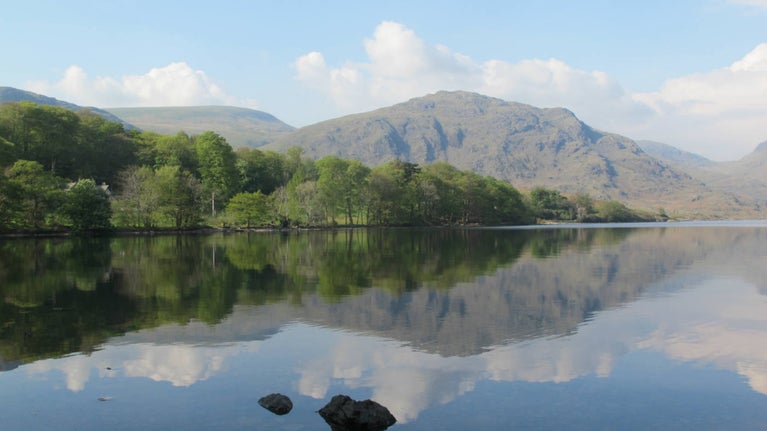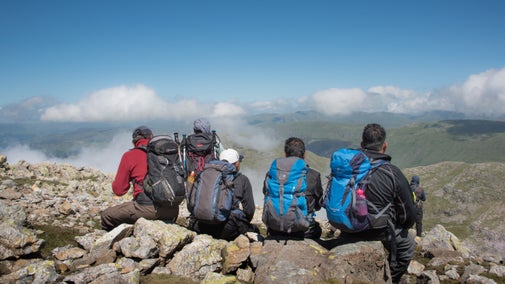
Make a donation
Everyone needs nature, now more than ever. Donate today and you could help people and nature to thrive at the places we care for.

Over 250,000 visitors come to Wasdale and Scafell Pike every year. Our rangers work tirelessly to protect the landscape and environment, while ensuring the safety of visitors. Find out about our restoration projects and discover how hydro power in the West Lakes is making a difference to our fossil fuel usage.
Until May 2018, Scafell Pike’s summit cairn – the stone structure which marks the highest point in England – was crumbling. The restoration of the cairn was a massive undertaking for the rangers and volunteers who camped out on the summit for over a week to rebuild the iconic structure.
The cairn represents much more than England's rooftop. After the end of the First World War the summit of Scafell Pike and surrounding land was gifted to the National Trust by Lord Leconfield as a memorial to the men of the Lake District who fell in the Great War. Look out for the war memorial plaque in the rocks of the cairn.
The summit cairn’s side walls had collapsed in recent years. These were fixed by the ranger team, but we also needed to create more substantial 'through' stones in the structure to make it more stable and able to support the number of visitors climbing it each year.
As well as ensuring the stability of the war memorial plaque, while the work was carried out a time capsule was placed into the stone wall which shares details of the work carried out and includes photos and information about our rangers.
The cairn continues to need maintenance and so the ranger team regularly head to the summit to carry out repairs.

An estimated 250,000 people visit the summit of Scafell Pike annually, which puts a lot of pressure on the surrounding environment. The increased footfall and the Cumbrian weather is leading to rapid erosion of paths, which is now an annual maintenance challenge. Working in partnership with Fix the Fells, there’s been extensive footpath restoration on both Scafell Pike and Great Gable to reduce the impact of thousands of pairs of feet and help protect the habitats of the rare plants found on the mountain.
In 2021, there was extensive work to repair worn sections of path on one of the most popular routes to Scafell Pike’s summit from Wasdale Head. By repairing and creating more resilient paths better capable of managing increasing visitor numbers, Fix the Fells aims to reduce soil, gravel, stone and peat degradation in upland areas. The damage results in the loss of rare upland habitats and species decline, as well as impacting on rivers and lakes below as sediment is washed off fellsides.
The six-month repair project concentrated on five sections of path totalling 1km in length and saw repairs and maintenance carried out from the valley bottom up to the summit top. The next area the upland team will focus on is at the upper section of the Hollowstones area, which is being badly eroded and the montane habitats damaged by the high numbers of users climbing the fell.
Everyone can help look after the Lake District while they are out and about enjoying the fells by wearing appropriate footwear, sticking to paths and not being afraid to get your boots muddy by going through rather than around puddles. Stepping to the side to let others pass at a safe distance before returning to the path to continue your walk will also help stop paths widening and wearing down surrounding grasslands.

While looking across to the screes, from the western shore of Wastwater, it is easy to overlook the patchwork of important wetland habitat on the edge of this great lake. The Greendale Mires contains an extensive network of both acid flushes and basin mires which is unique in West Cumbria. There are few intact areas of these nationally rare peatland habitats left which is why it has been afforded protection as a Site of Special Scientific Interest. Many important species make up this rare eco-system. The exotic looking carnivorous common sundew and long-leaved sundew can be found here as well as sunny bog asphodel and the peatland carbon-storing hero sphagnum moss. These are just a few of the wetland plants that work to filter the water, and capture carbon while supporting a range of wildlife on the lake shore.
This delicate area is nutrient poor and can be easily damaged by trampling or left-over waste but with more and more people coming to the valley and an increase in poor behaviour, the ranger team have had to put protective boulders along the roadside, increase patrolling and carry out litter picks to try to protect it. You can help them look after the landscape by always following the Countryside Code.

The Lake District gets plenty of rainfall so it’s a good place to install a green energy hydropower scheme. We aim to produce 50% of our energy from renewables and one of the ways we are working towards this target is to harness the energy that occurs naturally from the water that flows down our Lake District gills, becks and rivers.
Netherbeck in Wasdale, which has produced over 1 gigawatt (1 billion watts) of energy since it was commissioned in 2019, Whillan Beck in Eskdale and Crosby Gill in Duddon Valley are now running and producing energy. The ranger team carry out regular maintenance of the hydros: making sure the intake screens are clean and that the generators are greased and running efficiently. They have planted up riparian zones around the becks with over 500 trees being planted at Hazel Head farm.
Conservation and nature are at the heart of everything we do and keeping the river flowing is our priority. The hydro intake removes water flowing through the beck, but it is ‘consented flow’, meaning that the amount removed has been calculated by the Environment Agency following a years’ worth of beck monitoring. It ensures that more than enough water remains in the river, before some is diverted, and doesn’t negatively impact on downstream habitats. During dry weather, there will be less water, and in turn the hydro will slow and generate less electricity.
Your car parking payments and donations help to protect the woodland and water. They also contribute to managing and conserving habitats and helping the fells remain accessible for everyone. When you scan your membership card when you visit, we receive more money for our work in Wasdale.

Everyone needs nature, now more than ever. Donate today and you could help people and nature to thrive at the places we care for.

Explore Wasdale to discover England’s highest mountain peak and its deepest lake, and everything else that this area of the Lake District has to offer.

Find out more about how to prepare for climbing Scafell Pike, England’s highest mountain peak, and follow safety procedures.

The Lake District is a popular place to visit, but this means the footpaths become eroded which, along with weather events and climate change means the fells are in need of repair. Money from this appeal will directly improve this unique UNESCO World Heritage landscape.

We believe that nature, beauty and history are for everyone. That’s why we’re supporting wildlife, protecting historic sites and more. Find out about our work.

Read about our strategy, which focuses on restoring nature, ending unequal access and inspiring more people.

Learn about the traditional farming practices in the Lake District and how the National Trust works with farm tenants to restore vital habitats, protect wildlife and support quality local produce.